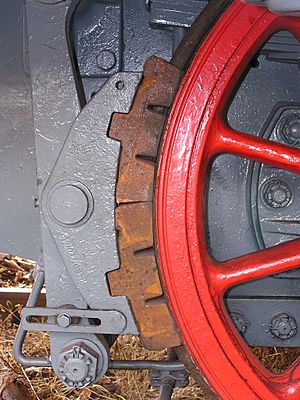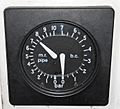Railway brake facts for kids
Railway brakes are super important parts of trains. They help trains slow down, stop, and even stay still when parked. Imagine a train going down a big hill – brakes help it control its speed so it doesn't go too fast! There are different kinds of brakes, like vacuum brakes and air brakes, which we'll learn more about.
Contents
Why Trains Need Brakes
Trains are very heavy and can move incredibly fast. Because of their weight and speed, they need powerful brakes to stop safely. Without good brakes, trains couldn't control their movement, making them dangerous.
Stopping and Slowing Down
The main job of train brakes is to make the train slow down or stop completely. When a train driver wants to stop at a station, they use the brakes to gently reduce the train's speed until it comes to a halt.
Controlling Speed on Hills
When a train travels down a slope or a hill, gravity tries to make it go faster and faster. Brakes are used to control this speed, keeping the train at a safe pace. This is called "controlling acceleration" or "dynamic braking."
Keeping Trains Parked
Just like a car needs a parking brake, trains need brakes to stay still when they are parked. These brakes make sure the train doesn't roll away when no one is driving it.
How Train Brakes Work
Most modern train brakes work by pushing a special material, called a brake shoe or pad, against the train's wheels. This creates friction, which turns the train's movement energy into heat, slowing the train down.
Air Brakes Explained
Many trains use "air brakes." These brakes use compressed air (air squeezed into a small space) to work.
- When the driver wants to stop, they release air pressure in a special pipe that runs along the train.
- This change in pressure tells brake parts on each car to push the brake pads against the wheels.
- To release the brakes, the driver increases the air pressure again, which pulls the pads away from the wheels.
Vacuum Brakes Explained
Older trains, or some trains in certain parts of the world, might use "vacuum brakes." These work in a similar way to air brakes but use a vacuum (a space with very little air) instead of compressed air.
- A pump on the train creates a vacuum in a pipe running through the train.
- When the driver wants to brake, they let air into this pipe.
- The change in pressure makes the brakes engage, pushing pads against the wheels.
Different Kinds of Brakes
Over time, many different types of brakes have been invented for trains. Each type has its own way of slowing down the train.
Friction Brakes
Most railway brakes are "friction brakes." This means they use rubbing (friction) to slow things down.
- Tread Brakes: These are the most common type. They push brake shoes directly onto the tread (the part that touches the rail) of the wheel.
- Disc Brakes: Some trains use disc brakes, similar to those in cars. A special disc is attached to the wheel, and pads squeeze this disc to create friction.
Other Brake Types
Besides friction brakes, there are other ways trains can slow down.
- Electrodynamic Brakes: These brakes use electricity to slow the train. They turn the train's movement into electrical energy, which can sometimes even be sent back to the power lines to save energy!
- Magnetic Brakes: Some trains have magnets that can be lowered to just above the rails. When activated, these magnets create a strong force that helps slow the train down without touching the wheels.
History of Railway Brakes
Early trains didn't have very good brakes. Workers often had to manually apply brakes on each car, which was slow and dangerous.
Early Hand Brakes
In the very beginning, brakes were simple levers that workers had to pull by hand on each train car. This meant it took a long time to stop a train, and all the brakes might not be applied at the same time.
The Invention of Air Brakes
A very important invention was the air brake by George Westinghouse in 1869. This allowed the driver in the locomotive to control the brakes on every car in the train at the same time. This made trains much safer and faster.
Modern Brake Systems
Today's trains have very advanced braking systems. They are often controlled by computers and can stop trains smoothly and efficiently. These modern systems are a big reason why train travel is so safe.
Images for kids
-
Driver's duplex air brake gauge; left needle shows main reservoir pipe supplying the train, right needle shows the brake cylinder pressure in bar
-
Four-step brake handle on a UK Class 317 Electric Multiple Unit
See also
 In Spanish: Freno (ferrocarril) para niños
In Spanish: Freno (ferrocarril) para niños








